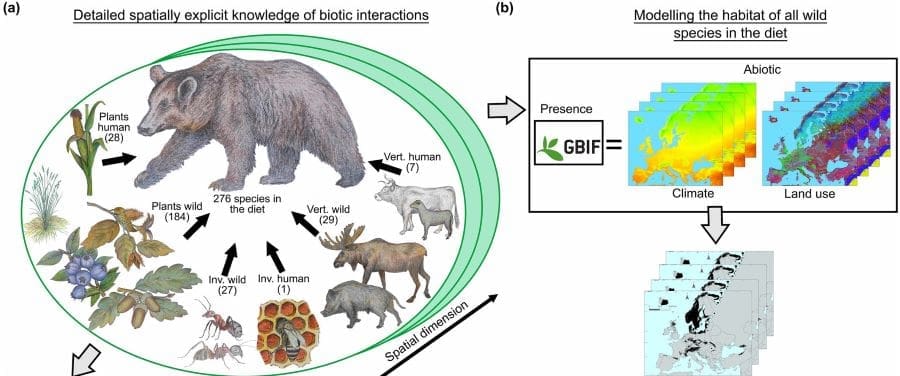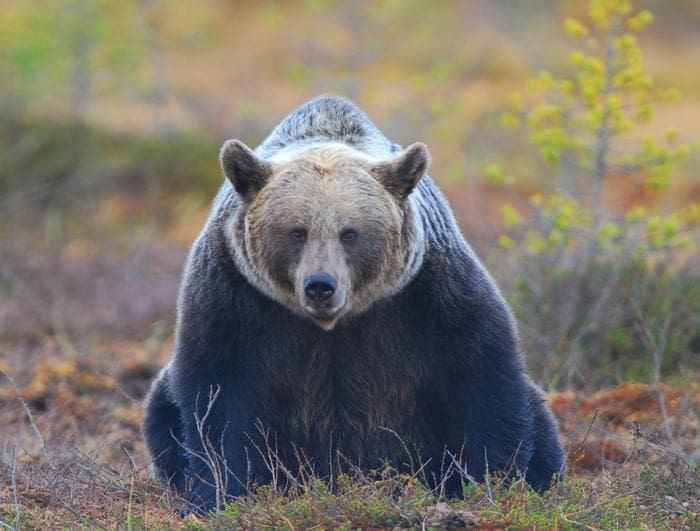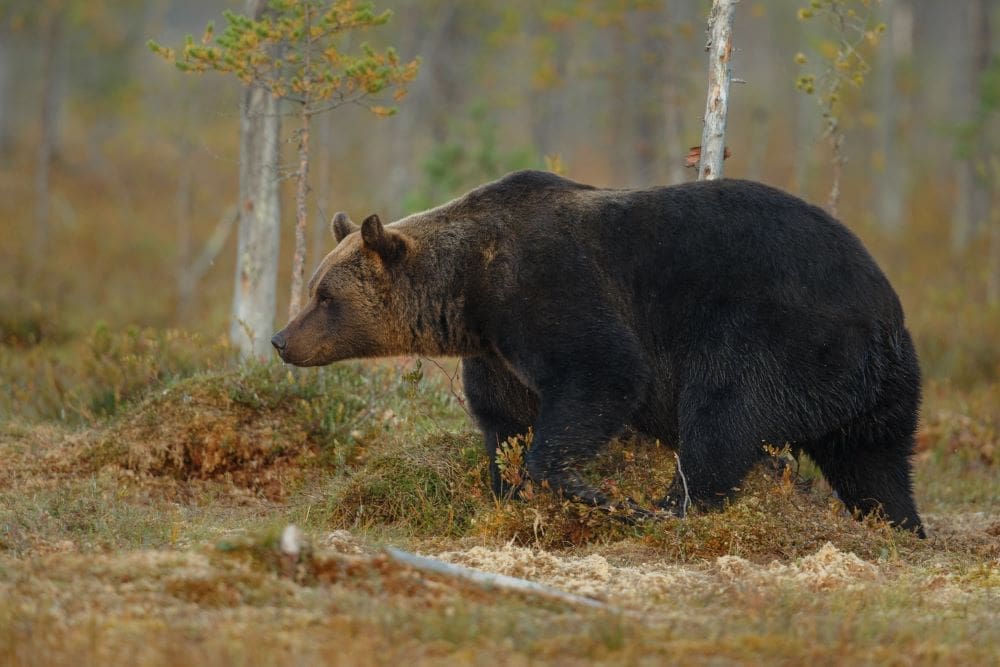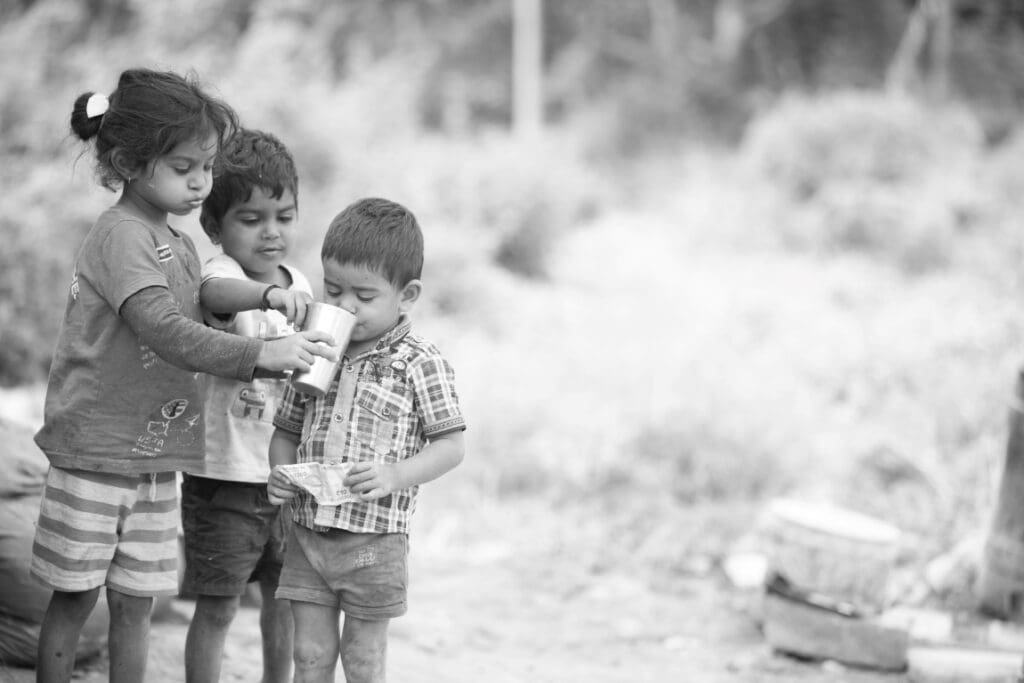Summary:
The distribution of brown bears across Europe is being reshaped not only by climate change and land-use transformation, but also by the availability of their diverse food sources, according to a large-scale study published in Global Change Biology.
Led by the University of Seville, La Sapienza University of Rome, and the Institute of Nature Conservation in Poland, the research involved 87 scientists from 75 institutions across 26 countries. The team created a high-resolution, spatially dynamic food web based on 276 species consumed by brown bears, combining this with habitat models and over three million bear location records.
The study shows that biotic interactions – particularly the distribution of species that make up the bears’ diet – play a key role in determining where bears are found at the continental scale. For instance, oak and beech availability supports sub-populations in the Cantabrian Mountains, while wild ungulates help sustain bears in colder regions like Finland and Scandinavia. The findings suggest that species distribution models based only on temperature or land use may miss critical drivers of future biodiversity changes. Understanding these indirect ecological effects is essential for predicting species responses and conserving ecosystem functions in the face of global environmental change.

Climate change and interactions between species are changing the distribution of brown bears in Europe
An international team led by the University of Seville, La Sapienza University of Rome and the Institute of Nature Conservation in Poland has studied how interactions between species affect the distribution of brown bears in Europe and Turkey. It has been found that the distribution of bears on a continental scale is largely explained by interaction with other species: specifically, bears occupy areas where the species that form part of their diet are distributed.
The research shows the importance of interactions between species on a continental scale, using the brown bear as a case study.
Understanding how global changes – such as climate change or land use transformation – affect species is critical to conserving biodiversity and maintaining the benefits that nature provides, such as clean water, soil fertility and pollination. For example, as a result of climate change, the distribution of some species is shifting to higher altitudes or towards the poles, where climatic conditions remain within the species’ tolerances. Until now, most studies have focused only on the importance of direct changes, such as changes in temperature, rainfall or agricultural use, on species distributions. However, this work has turned the spotlight on indirect effects through interactions between species.

“The bears showed a very varied diet: we detected 276 species in their diet. Bears living in warmer places, such as sub-populations in the Cantabrian Mountains, Greece or Turkey, have a more vegetarian diet, while in colder areas such as Scandinavia and Finland, bears are more carnivorous. This means that the role of bears in the ecosystem/food chain is different, varying between herbivore and apex predator,” explains US researcher Pablo M. Lucas. “Thanks to our large international team, we had more than three million bear locations, corresponding to some 3,000 bears and, very importantly, data from the 14 European and Turkish sub-populations, which inhabit very different environments.
“This allowed us to study the effects of local interactions over a continental area. We observed that bears occupy those places where the most energy from the species in their diet is available. For example, in the Cantabrian Mountains, the presence of oak and beech trees, which are the main food source for this sub-population, makes the presence of bears more likely; in other sub-populations where bears are more carnivorous, the presence of bears is better explained by the distribution of wild ungulates such as wild boar and deer.”
This information is particularly important for predicting where species will live in the future and what roles they play in ecosystems, in a context of climate change and land use transformation, and for understanding that in order to protect species, we must conserve the ecosystems where they live. “Changes in the distribution of the species they feed on may affect the bear’s position in the food chain and the viability of the species at the local level,” the researcher points out.
Other species with characteristics different from those of brown bears – such as a more specialised diet, less ability to move, or the ability to live only in very specific environmental conditions – may react differently to climate change, land use transformation, and changes in the species with which they interact. Improving this knowledge is essential for designing more effective strategies for conserving biodiversity and the services that nature provides us.
***
This work was carried out by a team of 87 researchers from 75 institutions in 26 countries, led by a researcher from the University of Seville (US). In addition to the US, other Spanish institutions are involved, such as the National Museum of Natural Sciences (MNCN-CSIC), the Doñana Biological Station (EBD-CSIC) and the University of Huelva.
Journal Reference:
Lucas, P.M., Thuiller, W., Talluto, L., Polaina, E., Albrecht, J., Selva, N., De Barba, M., Penteriani, V., Guéguen, M., Balkenhol, N., Dutta, T., Fedorca, A., Frank, S.C., Zedrosser, A., Afonso-Jordana, I., Ambarlı, H., Ballesteros, F., Bashta, A.-T., Bilgin, C.C., Bogdanović, N., Bojārs, E., Bojarska, K., Bragalanti, N., Brøseth, H., Chynoweth, M.W., Ćirović, D., Ciucci, P., Corradini, A., De Angelis, D., de Gabriel Hernando, M., Domokos, C., Dutsov, A., Ertürk, A., Filacorda, S., Frangini et al., ‘Trophic Interactions Are Key to Understanding the Effects of Global Change on the Distribution and Functional Role of the Brown Bear’, Global Change Biology 31, 6: e70252 (2025). DOI: 10.1111/gcb.70252
Article Source:
Press Release/Material by University of Seville (US)
Featured image credit: vladimircech | Freepik




